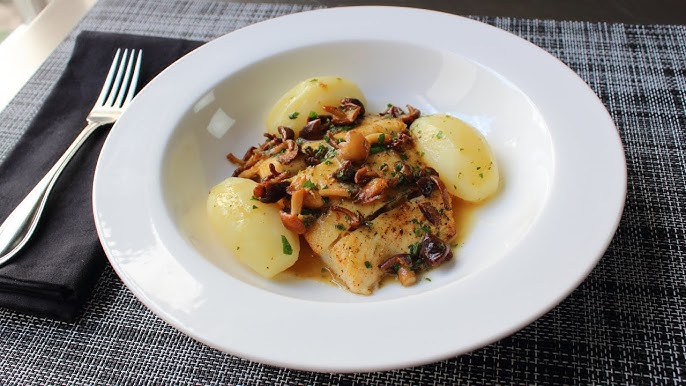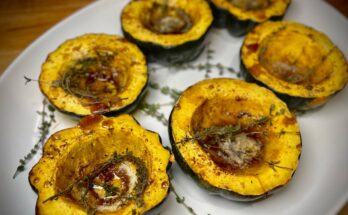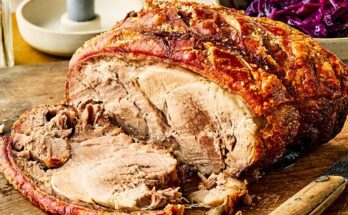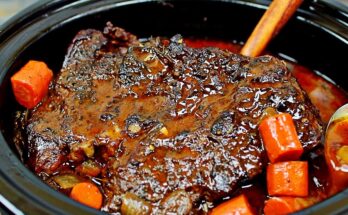Baked Halibut Recipe: Ever tried halibut? This lean, flaky fish isn’t just delicious—it’s downright magical when baked just right. If you’re aiming to impress at dinner without spending hours in the kitchen, baked halibut is your new best friend. Whether you’re a seafood lover or just easing into healthier eating habits, this recipe hits all the right notes. It’s packed with protein, low in fat, and so versatile you can serve it with nearly anything—think roasted veggies, garlic rice, or a zesty citrus salad.
Halibut has a mild, slightly sweet taste that doesn’t overwhelm your taste buds. That makes it perfect for marinades and seasonings because it soaks up flavors like a sponge. And let’s be honest—who doesn’t love a quick, flavorful meal that makes you feel like a gourmet chef without the stress?
But the best part? Baked halibut cooks in under 20 minutes. So, if you’re racing against the dinner clock or just don’t feel like hovering over a stove, this dish is your golden ticket to an easy, nutritious, and mouthwatering meal.
Ingredients You’ll Need
Let’s talk shopping list. You don’t need anything fancy—just a few pantry staples and quality fish. Here’s what to gather:
- Halibut fillets (4 to 6 oz each, skinless)
- Olive oil – extra virgin for richer flavor
- Lemon juice – fresh-squeezed is best
- Garlic – minced or crushed
- Paprika – for subtle smoky flavor
- Salt & black pepper – to taste
- Fresh herbs – like parsley or dill
- Optional: white wine, capers, or butter for extra richness
Fresh vs. Frozen Halibut: Fresh halibut has a clean, oceanic scent and firm texture. But don’t worry if it’s out of season or pricey—frozen halibut works beautifully too. Just make sure it’s wild-caught and vacuum-sealed. Thaw it overnight in the fridge for best results.
Key Seasonings and Spices: This recipe sticks to classic Mediterranean-inspired flavors—citrusy, garlicky, and herby. However, halibut is a flavor chameleon. Feel like switching things up? Try Cajun seasoning for heat or a ginger-soy combo for an Asian twist. Just keep the balance: halibut loves bold flavors, but not too much of a good thing.
Preparing the Halibut
Great meals start with proper prep. Don’t skip this part—it sets the stage for that perfect flaky finish.
Thawing Tips: If you’re using frozen halibut, thaw it in the refrigerator overnight. In a pinch? Submerge the sealed fish in a bowl of cold water for about 30–60 minutes. Never use hot water or a microwave—it ruins the texture.
Trimming and Patting Dry: Once thawed, rinse your fillets gently under cold water and pat dry with paper towels. This removes any residual ice or moisture, helping your seasonings stick better and your fish bake more evenly. If the fillets have dark muscle lines or tough edges, trim them off with a sharp knife. You’re aiming for clean, even pieces that cook uniformly.
Creating the Marinade
Here’s where the magic happens—your marinade brings all the flavor. The beauty of halibut is how effortlessly it soaks up these vibrant notes.
Simple Marinade Recipe:
- 3 tablespoons olive oil
- 2 tablespoons lemon juice
- 2 garlic cloves, minced
- 1 teaspoon paprika
- ½ teaspoon salt
- ¼ teaspoon ground black pepper
- Optional: a dash of white wine for depth
Instructions:
In a small bowl, whisk together all ingredients until well combined. You want a mixture that’s silky, zesty, and slightly fragrant. Pour it over your halibut fillets in a shallow dish or zip-top bag. Let it marinate in the fridge for 15–30 minutes. Halibut doesn’t need long—too much time can break down its tender fibers and turn it mushy.
Tips for Deeper Flavor:
- Add a sprig of fresh thyme or rosemary to the marinade.
- Zest your lemon before juicing for an extra citrus punch.
- If you like heat, a pinch of red pepper flakes does wonders.
Step-by-Step Baked Halibut Instructions
Let’s get cooking. Here’s your foolproof method to achieving tender, flaky baked halibut every time.
Step 1: Preheat and Prep the Oven
Preheat your oven to 400°F (200°C). If you’re using a convection setting, 375°F will do. Line a baking sheet or shallow baking dish with parchment paper or lightly grease it with olive oil to prevent sticking.
Step 2: Place and Marinate the Fish
Place the marinated halibut fillets in the baking dish in a single layer. Pour any leftover marinade on top for extra moisture. If using, dot the top of each fillet with a pat of butter for added richness.
Step 3: Bake to Perfection
Bake uncovered for 12–15 minutes, depending on the thickness of your fillets. You’ll know it’s done when the fish flakes easily with a fork and turns opaque all the way through. Avoid overbaking—halibut dries out fast if you’re not careful.
Optional Finish: For a golden crust, broil the fillets on high for the last 2 minutes. Just keep a close eye—they can go from crispy to burnt in a heartbeat.
Serving Suggestions: Serve your baked halibut with lemon wedges, a drizzle of olive oil, and a sprinkle of chopped herbs. Pair with quinoa, sautéed greens, or roasted baby potatoes for a complete meal.
Serving Suggestions for Baked Halibut
One of the best things about baked halibut is its versatility. You can pair it with just about any side dish and still end up with a satisfying, balanced meal. But if you’re aiming for a restaurant-quality plate, here are some winning combos:
Fresh and Vibrant Veggies
Roasted asparagus, steamed green beans, or a medley of bell peppers and zucchini add color, crunch, and nutrients. A splash of lemon juice or balsamic glaze over the veggies can tie the entire plate together.
Wholesome Grains
Halibut pairs wonderfully with wild rice, quinoa, or couscous. You can cook them in chicken or vegetable broth for added flavor. Want something creamier? Try a light garlic mashed potato or a lemon-infused risotto.
Salads That Sing
A bright, citrusy salad with arugula, fennel, and oranges can cut through the richness of the fish. Or go Mediterranean with cherry tomatoes, kalamata olives, cucumbers, and feta tossed in olive oil and lemon.
Creative Sauces
- Lemon butter sauce: A classic choice—just melt butter with lemon juice and a touch of garlic.
- Herb yogurt dip: Mix Greek yogurt with dill, parsley, lemon zest, and a pinch of salt.
- Mango salsa: If you’re feeling tropical, chopped mango, red onion, cilantro, and lime make a fresh topping.
Whether you’re serving for a weeknight dinner or a fancy get-together, these sides and sauces elevate your halibut to the next level.
Health Benefits of Baked Halibut
Beyond its incredible flavor, halibut is a powerhouse of nutrition. Choosing baked over fried also means you’re skipping extra fats and unnecessary calories. Let’s break down the health perks:
Packed with Protein
Halibut delivers about 40 grams of protein per 6-ounce serving. That’s more than enough to keep you full, fuel your muscles, and stabilize your blood sugar.
Low in Fat, High in Omega-3s
While low in overall fat, halibut contains heart-healthy omega-3 fatty acids. These reduce inflammation, support brain health, and may even lower your risk of chronic diseases like heart disease and arthritis.
Rich in Micronutrients
Baked halibut is a great source of:
- Selenium: A powerful antioxidant that supports thyroid function.
- Vitamin B12: Vital for energy and red blood cell formation.
- Magnesium & Potassium: Important for muscle and nerve function.
Low-Calorie Delight
A single serving of baked halibut comes in at just under 200 calories (without extra butter or sauces), making it ideal for those watching their weight or counting macros.
Common Mistakes to Avoid When Baking Halibut
Even the best ingredients can go wrong if you’re not careful in the kitchen. Avoid these common mistakes to make sure your halibut stays tender and tasty:
Overcooking
The number one sin in fish cooking. Overbaking dries out halibut and leaves you with a tough, rubbery mess. Always check doneness with a fork—it should flake easily and still be moist inside.
Skipping the Marinade
Halibut has a delicate flavor and benefits greatly from a marinade. Skipping it means you miss out on a flavor boost. Even 15 minutes of marinating can make a big difference.
Using Too Much Heat
Baking at too high a temperature can cause the exterior to dry out before the inside cooks through. Stick to 400°F and consider tenting the fish with foil if it looks like it’s browning too fast.
Not Drying the Fish
Moisture is the enemy of a good sear or bake. If you don’t pat the fish dry, the seasonings won’t stick, and you’ll steam instead of roast.
Neglecting Rest Time
Give your baked halibut 2-3 minutes to rest after it comes out of the oven. This helps redistribute the juices and keeps the fish from drying out.
Variations of the Baked Halibut Recipe
Want to mix it up? You don’t have to stick to the same flavors every time. Here are a few fun and flavorful variations:
Mediterranean Style
Top with cherry tomatoes, kalamata olives, artichoke hearts, and a sprinkle of feta before baking. Finish with fresh oregano and a squeeze of lemon.
Asian-Inspired
Marinate in a mix of soy sauce, sesame oil, ginger, and garlic. Serve with stir-fried bok choy or jasmine rice.
Spicy Cajun
Rub fillets with Cajun seasoning and a bit of brown sugar. Bake and finish with a lime wedge for a zesty finish.
Herb-Crusted
Mix chopped fresh herbs (parsley, dill, thyme) with breadcrumbs and Parmesan. Press onto fillets before baking for a crunchy, savory topping.
These tweaks keep the dish exciting, letting you adapt it to whatever ingredients you have on hand or whatever mood strikes.
How to Store and Reheat Leftovers
Cooked halibut doesn’t stay perfect forever, but with the right steps, you can keep it tasting great even the next day.
Storing Baked Halibut
- Cool to room temperature before storing.
- Use an airtight container.
- Keep in the fridge for up to 3 days.
Avoid freezing baked halibut—it tends to dry out when reheated. If you must freeze it, wrap tightly in plastic and then foil, and use within 2 weeks.
Reheating Tips
- Use a low oven (275°F) and cover with foil to prevent drying.
- Add a splash of water or broth to retain moisture.
- Reheat only until warmed through—usually 10-15 minutes.
You can also flake cold halibut into salads or make fish tacos. Just add a fresh salsa or slaw and you’ve got a whole new meal.
How to Know When Halibut is Perfectly Cooked
Cooking halibut just right can feel like a bit of a balancing act—but once you know what to look for, it becomes second nature.
Visual Cues
- Flaky Texture: Perfectly cooked halibut should flake easily with a fork. If it’s resistant or mushy, it’s either undercooked or overcooked.
- Opaque Color: The fish should turn from translucent to an opaque white. If it still looks glossy and raw in the middle, it needs a few more minutes.
Internal Temperature
The safest and most accurate method is to use a food thermometer. The FDA recommends cooking fish to an internal temperature of 145°F (63°C). However, many chefs prefer stopping around 135°F and letting the residual heat bring it up while resting.
Firmness Test
Gently press the thickest part of the fillet with your finger. It should feel firm but still have a little give. If it feels rock hard, it’s overdone. If it’s too soft, it needs more time.
Halibut can go from perfect to dry in under a minute, so keep an eye on it, especially if you’re broiling or cooking thinner pieces.
Best Wines to Pair with Baked Halibut
Pairing wine with halibut is like finding the perfect dance partner—it’s all about balance and harmony. Because halibut is mild and often paired with citrus or herbs, white wines are the go-to.
Top Wine Picks
- Chardonnay: A lightly oaked Chardonnay enhances the buttery, flaky texture without overpowering the fish.
- Sauvignon Blanc: Crisp and citrusy, it mirrors the lemon in the marinade and fresh herbs.
- Pinot Grigio: Clean and neutral, it supports the flavor of the halibut without stealing the spotlight.
- Albariño: A hidden gem—this Spanish white is slightly floral and acidic, making it an elegant match.
Serving Tips
- Chill your white wine to around 50°F (10°C).
- Avoid heavily oaked or overly sweet wines—they can mask the subtle flavors of the fish.
- If you’re serving spicy or Asian-style halibut, a light Riesling or Gewürztraminer also works wonders.
Baked Halibut for Special Occasions
Halibut might be simple to cook, but it doesn’t have to feel casual. With a few tweaks, this humble recipe can become the star of a special dinner.
Romantic Dinners
Serve halibut over a creamy risotto, light some candles, and pour a glass of white wine. Add a drizzle of truffle oil or a champagne reduction sauce to make it extra luxurious.
Holiday Feasts
Halibut is a great non-traditional option for Easter, Christmas Eve (especially for the Feast of the Seven Fishes), or even Thanksgiving if you’re avoiding poultry. Add a side of roasted winter vegetables and a herbed compound butter.
Dinner Parties
Presentation matters—plate it with vibrant sides like beet puree or rainbow carrots. Top with microgreens or edible flowers for that restaurant-worthy finish.
Impress your guests with how elegant and delicious a simple baked fish can be.
Environmental Impact of Halibut Fishing
Caring about where your food comes from is part of being a conscious cook. Halibut can be sustainably sourced—but not all fishing methods are created equal.
Sustainable Sources
Look for halibut that is:
- Wild-caught in Alaska or Canada – These regions have strict regulations to prevent overfishing.
- MSC Certified – The Marine Stewardship Council label ensures sustainability.
What to Avoid
- Halibut caught using bottom trawling methods, which damage ocean floors.
- Fish from overfished populations, particularly some Atlantic halibut stocks.
Support Sustainable Brands
Shop at trusted fish markets or online seafood companies known for ethical practices. Not only is this better for the planet—it usually tastes better too.
Final Tips for the Best Baked Halibut
Before we wrap up, here are a few last tips that can elevate your halibut game from good to unforgettable:
Use a Meat Thermometer
Seriously—it takes the guesswork out of doneness and ensures perfect results every time.
Let It Rest
Give it a couple of minutes after baking. This helps lock in those juices and makes for a more tender bite.
Layer the Flavor
Don’t just rely on the marinade. Think: lemon slices baked on top, fresh herbs sprinkled before serving, or a finishing drizzle of olive oil or herb butter.
Don’t Crowd the Pan
Spacing out your fillets ensures even cooking. Overcrowding can lead to steaming instead of baking.
FAQs About Baked Halibut Recipe
Q1: What is the best temperature to bake halibut?
The ideal temperature to bake halibut is 375°F (190°C). This allows the fish to cook evenly, staying tender and flaky without drying out.
Q2: How long should I bake halibut?
Bake halibut for 12 to 15 minutes, depending on the thickness. A good rule of thumb is 10 minutes per inch of thickness. The fish is done when it flakes easily with a fork.
Q3: Should I cover halibut when baking?
It’s not necessary to cover halibut when baking, but if you want to keep it extra moist, you can loosely cover it with foil for the first half of the baking time.
Q4: How do I know when baked halibut is done?
Baked halibut is ready when it turns opaque and flakes easily with a fork. The internal temperature should reach 130°F to 135°F.
Q5: What are the best seasonings for halibut?
Popular seasonings include lemon, garlic, butter, dill, parsley, paprika, and black pepper. These bring out halibut’s mild, sweet flavor.
Q6: Can I bake halibut from frozen?
Yes, you can bake halibut from frozen. Add an extra 5–10 minutes to the cooking time and ensure it reaches a safe internal temperature of 145°F.
Q7: What side dishes go well with baked halibut?
Baked halibut pairs perfectly with roasted vegetables, wild rice, garlic mashed potatoes, quinoa, or a fresh garden salad.
Q8: How do I store and reheat leftovers?
Store leftover halibut in an airtight container in the refrigerator for up to 3 days. Reheat gently in the oven at 300°F or microwave in short bursts to avoid drying it out.
Conclusion
There you have it—a complete, no-fuss, flavor-packed baked halibut recipe that anyone can master. Whether you’re cooking for one or entertaining a crowd, this dish never fails to deliver. From choosing the right cut to creating a marinade that brings out its best flavors, baking halibut is both an art and a science—and now, you’ve got the skills to ace it.
So go ahead—grab those fillets, preheat that oven, and treat yourself to a dish that’s not only delicious but also healthy, elegant, and super easy to make.



